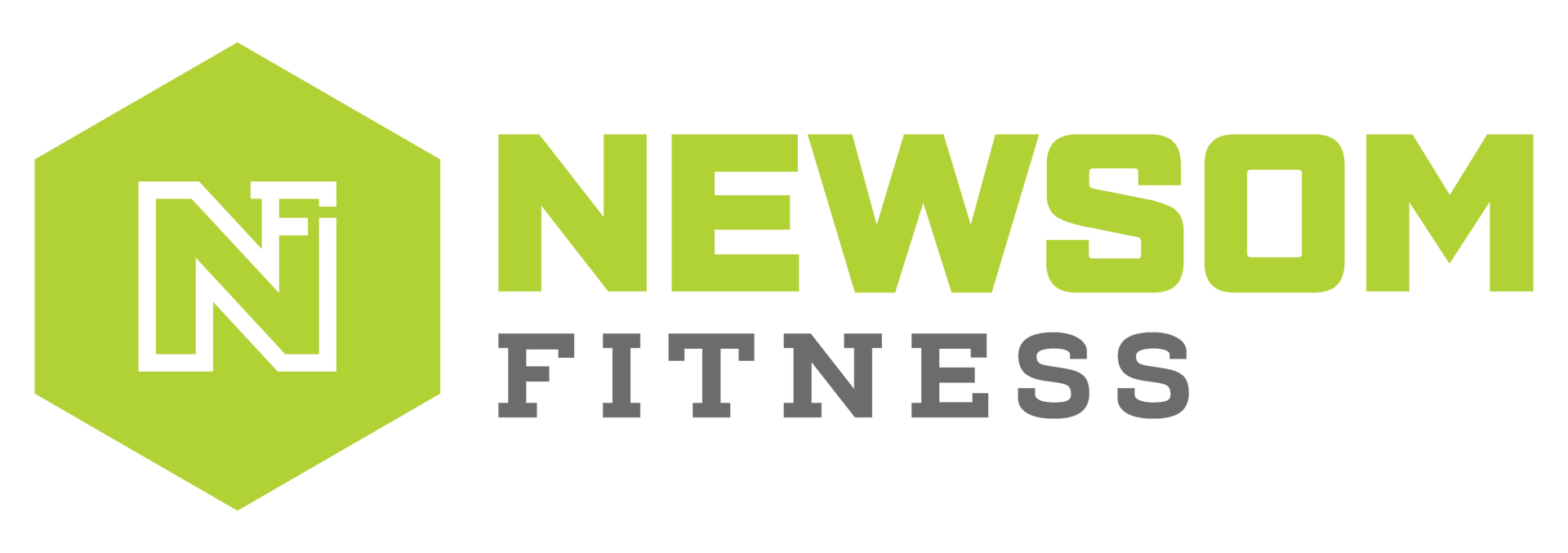Resistance Training: Building Strength, Enhancing Health, and Empowering Lives
At Newsom Fitness, we believe that resistance training, also known as strength training or weight training, is more than just an exercise routine—it’s a key to unlocking a healthier, stronger, and more empowered life. Resistance training focuses on maintaining and improving muscle quantity and quality, offering a broad range of benefits for individuals of all ages. Beyond enhancing athletic performance, it plays a vital role in improving health-related fitness, preventing chronic diseases, and supporting functional movement. It is a fundamental component of any well-rounded fitness regimen, complementing aerobic exercise and delivering distinct and powerful benefits.
As the world becomes more health-conscious, resistance training has gained traction across various populations. From athletes aiming to boost performance to older adults striving to maintain independence, resistance training has something to offer everyone. In 2008, the U.S. government formally recognized its importance by adding resistance training to the physical activity guidelines for Americans. These guidelines recommend that adults engage in moderate to high-intensity muscle-strengthening activities that target all major muscle groups at least two days per week. This advice is especially important for older adults, who can benefit even more from the protective effects of strength training.
In this comprehensive blog from Newsom Fitness, we’ll explore the science behind resistance training, its numerous health benefits, and its specific advantages for women and older adults. Whether you’re new to fitness or looking to enhance your current routine, resistance training is a powerful tool to help you build strength, improve health, and live an empowered life.
The Science Behind Resistance Training
Resistance training involves exercises that prompt muscles to contract against an external resistance. This resistance can come from free weights, resistance bands, machines, or even your own body weight. As you challenge your muscles, they adapt by growing larger and stronger—a process called hypertrophy. Over time, resistance training improves the body’s overall function, allowing you to perform everyday tasks more efficiently and with greater ease.
Research shows that resistance training yields numerous short- and long-term physiological benefits. According to Muñoz-López et al, these benefits include enhanced muscle hypertrophy, improved body composition, increased strength, better motor performance, and positive impacts on cardiovascular health, such as reduced blood pressure and improved insulin sensitivity. Resistance training also promotes bone mineral density, which is particularly important for preventing osteoporosis and reducing the risk of fractures as we age.
What makes resistance training even more compelling is its effect on both the muscular and neural systems. On the muscular side, it strengthens and enlarges muscle fibers. On the neural side, it enhances the nervous system’s ability to activate those muscles, resulting in better coordination, balance, and power during physical activities. The benefits are comprehensive and touch every aspect of physical health.
Historical Context of Resistance Training
The roots of resistance training stretch back to ancient civilizations, where strength and physical prowess were celebrated. In ancient Greece and Rome, events such as discus throwing, shot put, and wrestling showcased the importance of strength, speed, and power. These early displays of physical training laid the groundwork for modern resistance training practices.
Fast forward to today, and resistance training is recognized as an essential element of any well-rounded fitness program. It complements the benefits of aerobic exercise, which is critical for heart health and endurance. While cardio keeps the heart and lungs healthy, resistance training strengthens muscles, improves bone health, and boosts metabolic function. Together, these two forms of exercise create balanced fitness routines that promote long-term health and well-being.
In 2008, resistance training was officially included in the U.S. physical activity guidelines, emphasizing its importance in maintaining health and preventing disease. These guidelines advise adults to engage in muscle-strengthening exercises targeting all major muscle groups on at least two days per week. This inclusion demonstrates the growing recognition of resistance training as a vital part of overall fitness.
Benefits of Resistance Training
At Newsom Fitness, we know that resistance training offers a wealth of benefits that go beyond building muscle. From improving mental health to reducing the risk of chronic diseases, resistance training is an essential part of any fitness journey. Let’s explore some of the most notable benefits:
1. Muscle Hypertrophy and Strength
Muscle hypertrophy refers to the increase in muscle size that occurs as a result of resistance training. When you challenge your muscles with progressively heavier resistance, the body responds by building stronger, larger muscles. This not only enhances athletic performance but also improves everyday functionality.
For athletes, increased muscle mass translates to improved performance in activities that require explosive movements, such as sprinting, jumping, or weightlifting. For non-athletes, it means having the strength and endurance to perform daily tasks, such as lifting groceries, climbing stairs, or carrying children, with greater ease.
Muscle strength also plays a key role in maintaining a healthy metabolism. Since muscle tissue burns more calories at rest than fat tissue, increasing your muscle mass can help with weight management and fat loss. When combined with cardiovascular exercise and a healthy diet, resistance training is an effective strategy for achieving and maintaining a healthy body composition.
2. Bone Health
One of the most significant benefits of resistance training, especially as we age, is its positive impact on bone health. As we get older, bone density naturally declines, increasing the risk of osteoporosis and fractures. This is especially concerning for postmenopausal women, who experience a sharp drop in estrogen levels that accelerates bone loss.
Resistance training works to counteract this process by stimulating bone remodeling, where old bone tissue is replaced with new, stronger tissue. By engaging in weight-bearing exercises, you can increase bone density and reduce the risk of fractures and osteoporosis. For older adults and individuals at risk for bone-related issues, resistance training is an invaluable tool for maintaining bone strength and health.
3. Cardiovascular Health
While often associated with muscle building, resistance training also delivers significant cardiovascular benefits. Studies have shown that resistance training can improve cardiovascular risk factors such as insulin resistance, glucose regulation, and lipid metabolism. It can also help lower blood pressure and improve cholesterol levels, contributing to overall heart health.
For individuals with type II diabetes or metabolic syndrome, resistance training can be particularly effective in managing blood sugar levels and enhancing insulin sensitivity. By reducing body fat and increasing muscle mass, resistance training helps regulate glucose metabolism, making it easier for the body to process carbohydrates.
4. Mental Health and Cognitive Function
The mental health benefits of resistance training are just as important as the physical ones. Regular exercise, including resistance training, has been shown to reduce symptoms of anxiety, depression, and stress. The release of endorphins during exercise creates a natural "feel-good" effect that can help boost mood and promote mental well-being.
Moreover, resistance training has been linked to improved cognitive function, especially in older adults. Regular strength training can help slow the cognitive decline associated with aging and enhance memory, attention, and executive function. These cognitive benefits are critical for maintaining mental sharpness and preventing conditions such as Alzheimer’s disease.
5. Improved Daily Functionality
At Newsom Fitness, we understand that one of the most practical benefits of resistance training is its ability to improve performance in everyday life. Whether it’s lifting, bending, or carrying, the strength and functional capacity gained from resistance training make daily tasks easier and less physically taxing.
This improved functionality is particularly important for older adults who may struggle with mobility or balance issues as they age. Resistance training strengthens muscles, enhances coordination, and improves balance, all of which are critical for maintaining independence and reducing the risk of falls. By improving joint stability and overall strength, resistance training helps individuals stay active and self-sufficient for longer.
Resistance Training for Women
At Newsom Fitness, we believe that resistance training is a powerful tool for women’s health—whether it’s for managing menopause, improving athletic performance, or simply staying fit. Let’s dive into some of the key factors and benefits of resistance training for women:
1. Barriers to Participation
Despite its benefits, many women hesitate to participate in resistance training due to misconceptions and cultural barriers. Some fear “bulking up,” while others may feel intimidated by weightlifting or worry about potential injuries. For older women, physical issues or concerns about pain can also prevent them from engaging in strength training.
At Newsom Fitness, we aim to break down these barriers through education and support. By dispelling myths and providing a safe, encouraging environment, we help women discover the transformative power of resistance training.
2. Benefits for Women’s Health
Resistance training offers significant health benefits for women, especially as they age. Regular strength training can help manage chronic conditions such as metabolic syndrome, fibromyalgia, and rheumatoid arthritis. Additionally, resistance training supports lean muscle mass, enhances insulin sensitivity, and aids in managing conditions like type II diabetes.
For postmenopausal women, resistance training is particularly important for maintaining bone density and reducing the risk of osteoporosis. By regularly engaging in weight-bearing exercises, women can increase bone strength and functional capacity, reducing the likelihood of falls and fractures.
Impact on Athletic Performance
For women interested in sports or competitive activities, resistance training is a game-changer. Strength training improves muscular endurance, agility, and power, allowing female athletes to perform at their peak. Whether it’s weightlifting, running, or CrossFit, resistance training helps women develop the strength, stamina, and balance necessary for success in sports.
Special Considerations for Aging Populations
At Newsom Fitness, we emphasize that resistance training is critical for healthy aging. As we age, we naturally lose muscle mass and strength—a condition known as sarcopenia. This decline can negatively affect balance, mobility, and overall functional capacity.
For older adults, especially women going through menopause, the loss of estrogen accelerates muscle and bone deterioration. This makes resistance training an essential tool for maintaining physical health and preventing issues like osteoporosis.
Resistance Training vs. Hormone Replacement Therapy (HRT)
Hormone replacement therapy (HRT) is commonly prescribed to help women manage symptoms of menopause, such as hot flashes, mood changes, and bone loss. However, HRT can have side effects, including headaches and breast tenderness.
As a natural alternative, resistance training offers many of the same benefits without the side effects. By engaging in regular strength training, women can improve bone density, maintain lean body mass, and promote overall physical and mental well-being—making resistance training an effective and empowering choice for managing menopause.
Conclusion
Resistance training is a powerful, versatile exercise modality that offers a wide range of physical, mental, and emotional benefits. From increasing muscle mass and strength to improving cardiovascular health and mental well-being, it’s a vital part of any fitness routine.
At Newsom Fitness, we encourage everyone—especially women and older adults—to make resistance training a regular part of their lives. Whether you’re new to fitness or looking to enhance your performance, incorporating resistance training will help you build strength, improve health, and lead an empowered life. Let’s get stronger together!




